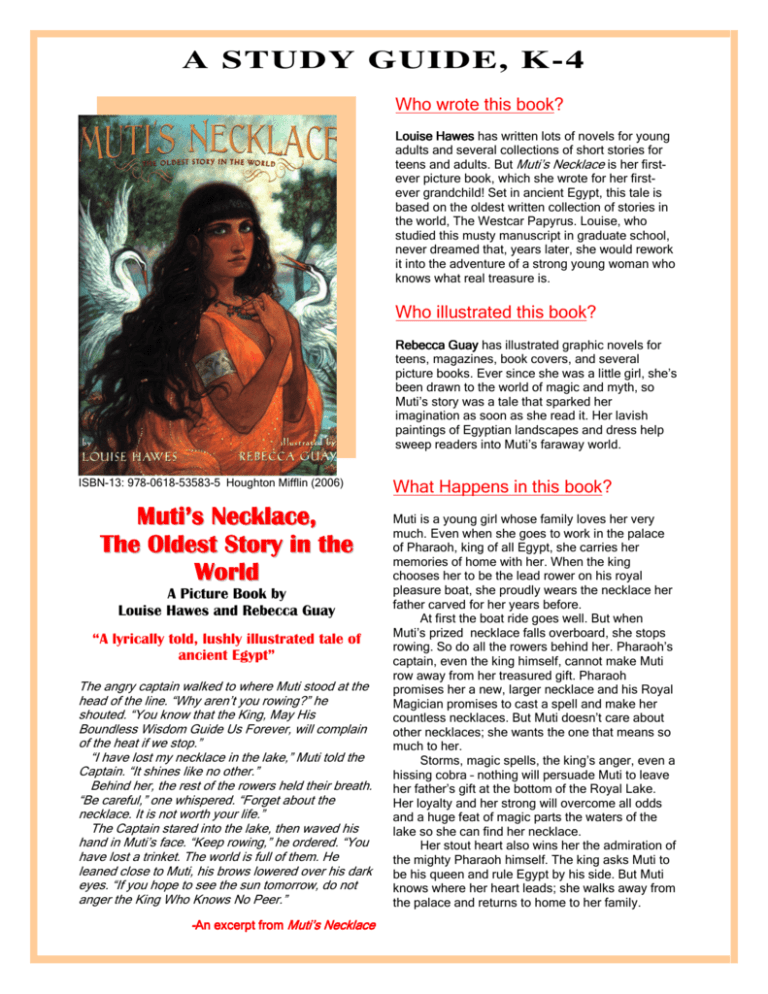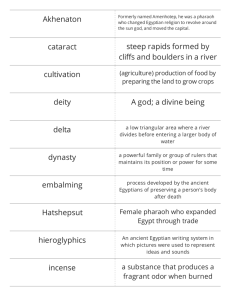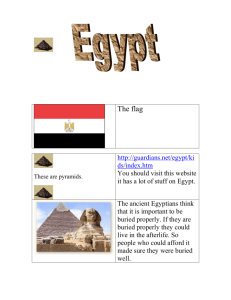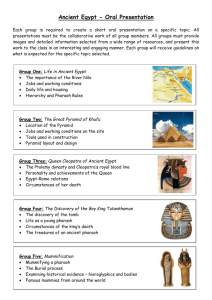A STUDY GUIDE, K-4 Muti's Necklace, The
advertisement

A STUDY GUIDE, K-4 Who wrote this book? Louise Hawes has written lots of novels for young adults and several collections of short stories for teens and adults. But Muti’s Necklace is her firstever picture book, which she wrote for her firstever grandchild! Set in ancient Egypt, this tale is based on the oldest written collection of stories in the world, The Westcar Papyrus. Louise, who studied this musty manuscript in graduate school, never dreamed that, years later, she would rework it into the adventure of a strong young woman who knows what real treasure is. Who illustrated this book? Rebecca Guay has illustrated graphic novels for teens, magazines, book covers, and several picture books. Ever since she was a little girl, she’s been drawn to the world of magic and myth, so Muti’s story was a tale that sparked her imagination as soon as she read it. Her lavish paintings of Egyptian landscapes and dress help sweep readers into Muti’s faraway world. ISBN-13: 978-0618-53583-5 Houghton Mifflin (2006) Muti’s Necklace, The Oldest Story in the World A Picture Book by Louise Hawes and Rebecca Guay “A lyrically told, lushly illustrated tale of ancient Egypt” The angry captain walked to where Muti stood at the head of the line. “Why aren’t you rowing?” he shouted. “You know that the King, May His Boundless Wisdom Guide Us Forever, will complain of the heat if we stop.” “I have lost my necklace in the lake,” Muti told the Captain. “It shines like no other.” Behind her, the rest of the rowers held their breath. “Be careful,” one whispered. “Forget about the necklace. It is not worth your life.” The Captain stared into the lake, then waved his hand in Muti’s face. “Keep rowing,” he ordered. “You have lost a trinket. The world is full of them. He leaned close to Muti, his brows lowered over his dark eyes. “If you hope to see the sun tomorrow, do not anger the King Who Knows No Peer.” -An excerpt from Muti’s Necklace What Happens in this book? Muti is a young girl whose family loves her very much. Even when she goes to work in the palace of Pharaoh, king of all Egypt, she carries her memories of home with her. When the king chooses her to be the lead rower on his royal pleasure boat, she proudly wears the necklace her father carved for her years before. At first the boat ride goes well. But when Muti’s prized necklace falls overboard, she stops rowing. So do all the rowers behind her. Pharaoh’s captain, even the king himself, cannot make Muti row away from her treasured gift. Pharaoh promises her a new, larger necklace and his Royal Magician promises to cast a spell and make her countless necklaces. But Muti doesn’t care about other necklaces; she wants the one that means so much to her. Storms, magic spells, the king’s anger, even a hissing cobra – nothing will persuade Muti to leave her father’s gift at the bottom of the Royal Lake. Her loyalty and her strong will overcome all odds and a huge feat of magic parts the waters of the lake so she can find her necklace. Her stout heart also wins her the admiration of the mighty Pharaoh himself. The king asks Muti to be his queen and rule Egypt by his side. But Muti knows where her heart leads; she walks away from the palace and returns to home to her family. Before You Read spells? How did the magic in those stories change things? Were the changes good or bad? Before you open the book, look at both covers, front and back: 3) If you were Pharaoh, king of all Egypt, why would you choose a serving girl like Muti to be your queen? Would you command her to stay with you? 1) Who do you think the two people in each picture are? What roles do you think they will play in the story? 2)How do you think the girl on the front feels about her necklace? Why? 4) If you lived in ancient Egypt, how would your life be different than it is now? What are some of the things you couldn’t do in Egypt that you can do now? Are there some things you could do in Egypt that you cannot do now? 3) What do you think the man on the back cover does for a living? Who do you think the man kneeling behind him is? 5) Do you have a gift from someone that is as precious to you as Muti’s necklace was to her? Who gave it to you? What is special about it? 4) Where do you think the story takes place? For a clue, you can also open the book and look at pages 2 and 3, where the author and illustrator have written their dedications. What do you see in the background here? What do you know about these ancient buildings? What do you know about the people who built them? After You Read As You Read LET’S TALK ABOUT THE STORY 1) Why is Muti’s necklace so special to her? Why doesn’t she ever take it off? Can you describe a day with Muti’s family – how do they spend their time? 2) How does Muti’s life change when she goes to work for Pharaoh, the king of Egypt? What are her jobs in the palace? Does she dress differently? What are some of the things she misses from home? ARTS AND CRAFTS Cooperate with others in your class to build the pyramids! You’ll need a tray, some sand, some stay-soft modeling clay and some paints: Fill the tray with a half inch of sand. Make three pyramids out of clay. (If the clay is not white, you’ll need to paint them white.) Set the pyramids in the sand. Model and paint some camels and some workers to build the pyramids. Model and paint some palm trees and put them in the sand, too. Find a small, round mirror and bury it in the sand to serve as a pond or lake. Make a boat for the lake. HINT: Use the pictures in Muti’s story as well as some of the books below to find out what your clay figures should be wearing and what sort of boat might be sailing on your mirror lake ! MUSIC 3) Does the Pharaoh have to work? What does he do? Does he dress differently than modern rulers do? Does he act differently than the President of our country or the leaders of other nations? How? Remember the song, “Row, row, row your boat?” Sing the song in rounds, but change the words to go with Muti’s story: 4) Why is everyone afraid of the magician? Why isn’t Muti? Row, row, row your boat gently ‘round ‘round the lake. Slowly, slowly, slowly, slowly, Your necklace mustn’t break! 5) Look at the picture of the palace at the end of the book. Now turn back to the picture of Muti’s house on pages five and six. What are the differences between these two places to live? Which one does Muti choose? Why? LET’S THINK ABOUT THE STORY 1) If you were Muti, what is the first thing you would do when you get home from the palace? What would you tell your father? Mother? Brother? 2) If you were the Royal Magician, what magic words would you use to make the water in the lake move? Can you think of other stories about magic HINT: It’s more fun to stand up and pass a necklace around as you sing. When each verse ends, whoever has the necklace has to sit down. Keep singing until there’s only one person standing! S/he’s the Pharaoh! ENGLISH/SOCIAL STUDIES Use the book about hieroglyphs or go online (book and site listed below) to find out what your name looks like in Egyptian writing. Make a nametag for yourself with your name in hieroglyphs. Make one for each person in your family! Where to Learn More About Ancient Egypt IN BOOKS: BOOKS: Hieroglyphs, by Joyce Milton (Grosset and Dunlap, 2000). With stencils, so you can write your own names and other things in hieroglyphs! Ancient Egypt, Eyewitness Books by George Hart (Alfred Knopf, 1990) Big, beautiful, thorough. Ancient Egypt (Modern Rhymes About Ancient Times) by Susan Altman, Susan Lechner, pictures by Sandy Appleoff (Children’s Press, 2002) Solid poetry, good poetry, genuine fun and learning combined. Pyramids: 50 Hands-On Activities to Experience Ancient Egypt (Kaleidoscope Kids) by Avery Hart and Paul Mantell, pictures by Michael Kline (Williamson Publishing, 1997) Fun, informative, and packed with projects! ON THE WEB: WEB: http://www.eyelid.co.uk/e-name.htm (write your whole name in hieroglyphics at the touch of a key!) http://www.historyforkids.org/learn/egypt/index.htm (one of the best kids’ history sites on the web, this section on Egypt features information on history, clothing, food, games, art and more; scholar-vetted articles that are brilliant AND fun!) http://www.touregypt.net/kids/life.htm (life in ancient Egypt, click for games and stories!) http://www.ancientegypt.co.uk/life/home.html (you can read stories about two sorts of Egyptians – one lives in a palace, the other in a hut; you can take a journey on a map while another story unfolds) ESPECIALLY FOR TEACHERS http://www.dia.org/education/egypt-teachers/index.html (great lesson plans across the curriculum!) http://www.ancientegypt.co.uk/menu.html# (the British Museum’s Egypt website for kids; the Staff Room link includes excellent teacher resources!) http://www.proteacher.com/cgibin/outsidesite.cgi?id=17227&external=http://www.coloring.ws/egypt.htm&original=http://www.proteacher. com/090012.shtml&title=Ancient%20Egypt%20Coloring%20Page (good quality, printable coloring pages on ancient Egypt) AN OLD EGYPTIAN BLESSING ankh, wedja, seneb (life, prosperity, and health)








